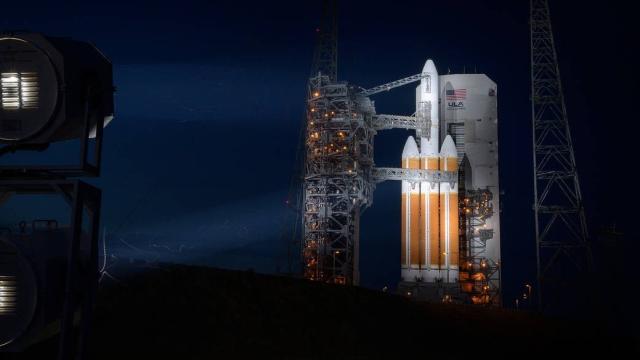As the band Europe once sang, it’s the final countdown, at least for United Launch Alliance’s Delta IV Heavy, which is set to retire following its final flight on Thursday, March 28. The classified mission also marks the end of an era that began more than 60 years ago, with ULA bidding farewell to the Delta series.
The triple core rocket is slated to launch at 4:40 a.m. AEDT on Friday, blasting off from Space Launch Complex-37 at Cape Canaveral Space Force Station in Florida. The weather forecast isn’t great, with ULA predicting a 30% chance of favorable conditions. Should bad weather force a scrub, ground teams will try again 24 hours later. The Delta IV Heavy is carrying a classified payload for the National Reconnaissance Office, likely a spy satellite, as part of the NROL-70 mission.
In its press materials, ULA described the Delta IV Heavy as the “most metal” of rockets. The reason for this has to do with the dramatic, and even startling, way in which the rocket blasts off. Seconds before its engines roar to life, a fireball engulfs the base of the rocket, causing a fire that chars the booster exterior.
This has to do with excess hydrogen burn-off. Prior to ignition, hydrogen fuel creeps out from the engines and up the side of the booster (it’s like starting a gas cooktop or a propane barbecue—some gas has to escape before you click the ignition button). When the engines are ignited, this excess hydrogen catches fire, causing the brief—but intense—fireball. This phenomenon is actually a normal and expected part of the launch process. A 2018 video (below) describes the process in more detail.
This is the last flight for the 235-foot-tall (72-meter) Delta IV Heavy, which debuted in 2002. It’s also the end of the road for the Delta program. The NROL-70 mission marks the 16th launch of Delta IV Heavy and the 389th for the Delta family, according to AmericaSpace. Established by the U.S. government in 1960, the Delta program was set up to develop a suite of expendable launch vehicles for space missions, ranging from satellite deployments to deep space explorations. ULA’s new Vulcan Centaur rocket, which debuted in January, is designed to replace the Deltas.
The two-stage Delta IV Heavy consists of three booster cores, each powered by a RS-68A engine. Each of these engines produce 705,000 pounds of force at liftoff, making it one of the most powerful liquid hydrogen/liquid oxygen engines in the world. For its second stage, the Delta IV Heavy uses a single RL10C-2-1 engine (also fueled by liquid hydrogen and oxygen), capable of generating 24,750 pounds of thrust. A 16-foot-tall (5-meter) payload fairing completes the assembly.
The Delta IV Heavy’s first launch on December 21, 2004, was a partial failure (the dummy payload didn’t reach the targeted orbit), but it remains the only blemish in an otherwise perfect career. Its first successful operational mission was in 2007, sending an NRO reconnaissance satellite into space. Notable missions include launching NASA’s Orion spacecraft for the EFT-1 mission in 2014 (Orion is now a key fixture of the space agency’s Artemis program) and the Parker Solar Probe in 2018.
At the time of its debut, the Delta IV Heavy was the most powerful rocket launched from Cape Canaveral, save for the Saturn V and the Space Shuttle Launch System, according to Florida Today. Currently, only NASA’s Space Launch System and SpaceX’s Falcon Heavy are more powerful (Starship doesn’t count, as it’s not yet ready for prime time). Its replacement, the 202-foot-tall (61.6-meter) Vulcan Centaur rocket, offers greater flexibility and can be configured with zero, two, four, or six solid rocket boosters to meet specific mission requirements.
So it’s out with the old and in with the new. The Delta IV Heavy has done its bit for king and country, but now it’s time for an update—and an overdue one at that. Vulcan represents ULA’s first new rocket design since the company began in 2006 (ULA, a joint venture between Lockheed Martin and Boeing, inherited Delta from its predecessors). Sure, we’ll miss those frightening fireballs at launch, but the future awaits.
